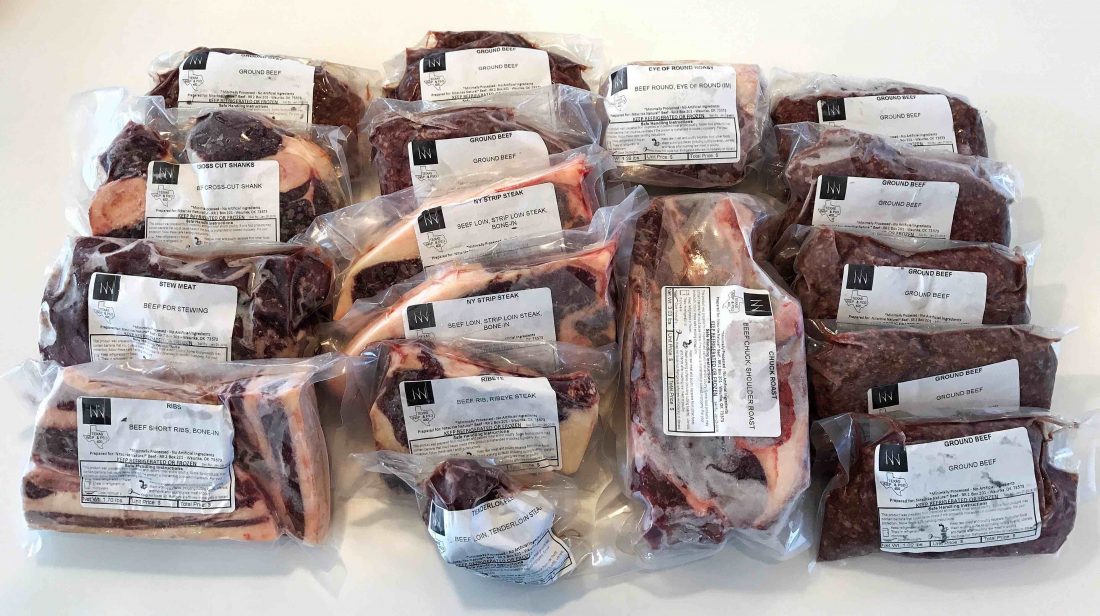Buying a large quantity of beef for the first time can be a bit intimidating. We get that for sure! Respecting the animal means making good use of as much of it as possible. It’s likely you now have a freezer full of delicious grassfed beef, and you might not know how to cook everything in there. Wonder no more; we’re gonna break it down right here:
Below is a list of cuts you might have received and what you can cook with them. Keep in mind that not every order is exactly alike. I tried to include all possible cuts, but if you have something you’re not sure how to cook, please reach out and I’ll help you. You can also reference our Cooking Methods post for best results – grassfed beef cooks differently than conventionally raised beef.
As always, please don’t hesitate to call, text, email or Facebook message with any questions or feedback. We want to know what we can do to serve you better and invite any feedback.
Individual Steaks (ribeye, strip, tenderloin/filet, chuck eye, picanha (aka coulotte), tri-tip): Refer to our Steak Grilling method for individual steaks, then slice any leftovers for a mouth-watering steak salad, or cut into kabob cubes to go with some fresh grilled veggies.
Larger Steaks (top sirloin, sirloin, flat iron, hanger, skirt, flank): These are great for a light marinade or rub and grilling, broiling or searing in a cast iron skillet, then a short finish in a warm (200 degree) oven.
All steaks can be started in a sous vide and finished on the grill or cast iron skillet, too.
Roasts (chuck, arm, rump, pikes peak, eye of round, loin tip): All these cuts become tender and succulent with the low and slow-braising slow cooker method. You can achieve very similar results in the oven by first doing the same searing and deglazing steps, then sealing up your meat and those delicious juices in a tightly covered Dutch oven, and braising your roast on low heat (300 degrees F) for several hours (4-5). Just be sure to increase the cooking liquid somewhat and maybe place your roast on a bed of roughly chopped aromatic vegetables like carrots, celery and onion to keep the bottom safe from over-browning.
Aside from the obvious Sunday Roast dinner presentation, you can shred the meat with forks (think pulled pork) to use in tacos, burritos, taco salads, scrambled eggs, soups and casseroles. Slice for some amazing sandwiches with horseradish, grainy mustard, and sauerkraut.
Brisket: A less tender part of the calf needing some gentle TLC, but still easy to produce delicious results. We’ve found that leaner grassfed brisket benefits from 24 hour marinades and low and slow oven braising where it can cook in those succulent juices and stay perfectly moist.
Short Ribs: Definitely not a lean cut, but one that picks up flavorful seasonings beautifully. A slow cooker is your best friend with these 2″ long flanken-style morsels of deliciousness. Here’s our family’s favorite – and super easy – recipe!
Bones: Keep ‘Em! This is where liquid nutritional gold is found! We throw all our leftover roast, rib, and steak bones in a freezer-safe zip top bag and save them til a 1 gallon bag is full. I add any raw bones that came with my order, or if that’s a bunch, add 3 or 4 to each batch, or cook only raw bones together. No hard & fast rules here. Throw them in your slow cooker, fill nearly to the top with purified water, then add 1T apple cider vinegar (we’re Bragg’s fans). Let the pot sit out, still off, for 1 hour. This allows the vinegar time to start breaking down the bones enough to let all those valuable minerals leach out into your broth as it slow cooks over the next couple of days. Cover and turn the pot to LOW and simmer at least 48 hours. Add more purified water at about 24 hours to refill what’s evaporated. This produces a rich bone broth packed with super important, but hard to get, trace minerals and collagen. It won’t be especially savory unless you opt to add some salt at this point, which I typically do. Another variation is to add some veggies and herbs to your starting pot – celery, carrots, onions, leftover veggies or scraps, parsley, thyme, peppercorns, etc. This will infuse even more flavor and nutrition and is a great way to make good use of your kitchen veggie scraps. I double strain the final broth, pressing down the solids on round one to release as much goodness as possible.
Alternate super easy method is to cook it in an InstantPot! I double the 4 hour broth setting to 8 for a richer, darker broth.
Gourmet Ground Beef: We cover a couple of fabulous ways to make great burgers in this easy guide. There are so many ways besides burgers to use and serve ground beef, we couldn’t possibly list them all, but some of our favorites include meatloaf, tacos, burritos, goulash, curry, taco soup, stuffed cabbage rolls, stuffed peppers, moussaka, any number of salsa-infused skillet meals, scrambled eggs, …
If you have some family favorites, we’d be honored to share your recipes and suggestions on our website!
Happy NNB Cooking!

